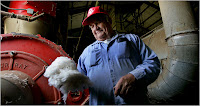 Texas "is rapidly turning into the capital of wind power," Clifford Kraus reports for the Times from Sweetwater, where Brian Harkin took this photo of workers on a wind turbine. "After breakneck growth the last three years, Texas has reached the point that more than 3 percent of its electricity, enough to supply power to one million homes, comes from wind turbines." According to the American Wind Energy Association, the No. 2 through 10 states in megawatts from wind are
Texas "is rapidly turning into the capital of wind power," Clifford Kraus reports for the Times from Sweetwater, where Brian Harkin took this photo of workers on a wind turbine. "After breakneck growth the last three years, Texas has reached the point that more than 3 percent of its electricity, enough to supply power to one million homes, comes from wind turbines." According to the American Wind Energy Association, the No. 2 through 10 states in megawatts from wind areWind power is booming "amid rising concern about greenhouse gases from coal-burning power plants," Krauss writes. "Installed wind capacity in the United States grew 45 percent last year, albeit from a small base, and a comparable increase is expected this year. At growth rates like that, experts said, wind power could eventually make an important contribution to the nation’s electrical supply. It already supplies about 1 percent of American electricity, powering the equivalent of 4.5 million homes. Environmental advocates contend it could eventually hit 20 percent, as has already happened in Denmark. Energy consultants say that 5 to 7 percent is a more realistic goal in this country."
There are downsides, Krauss notes: "Electricity from wind remains costlier than that generated from fossil fuels. Moreover, wind power is intermittent and unpredictable, and the hottest days, when electricity is needed most, are usually not windy. The turbines are getting bigger and their blades can kill birds and bats. Aesthetic and wildlife issues have led to opposition emerging around the country." But owners of the land where turbine towers are built are paid well. Krauss begins his story from the viewpoint of rancher Louis Brooks, who gets $500 a month for each of 78 towers on his land and is expecting 76 more, which would bring his wind income to $77,000 a month. (Read more)










